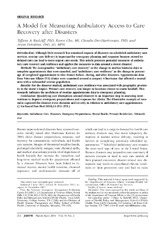| dc.creator | Radcliff, Tiffany A. | |
| dc.creator | Chu, Karen | |
| dc.creator | Der-Martirsosian, Claudia | |
| dc.creator | Dobalian, Aram | |
| dc.date.accessioned | 2018-03-21T17:27:17Z | |
| dc.date.available | 2018-03-21T17:27:17Z | |
| dc.date.issued | 2018-03 | |
| dc.identifier.citation | Radcliff, Tiffany A., Karen Chu, Claudia Der-Martirosian, and Aram Dobalian. “A Model for Measuring Ambulatory Access to Care Recovery after Disasters” Journal of the American Board of Family Medicine 31(2):252-259 | en |
| dc.identifier.issn | 1558-7118 | |
| dc.identifier.uri | https://hdl.handle.net/1969.1/166280 | |
| dc.description.abstract | Introduction: Although little research has examined impacts of disasters on scheduled ambulatory care
services, routine care delivery is important for emergency planning and response because missed or
delayed care can lead to more urgent care needs. This article presents potential measures of ambulatory
care recovery and resilience and applies the measures to data around a recent disaster.
Methods: We conceptualize “ambulatory care recovery” as the change in median business days to
complete appointments that were canceled, and “ambulatory care resiliency” as the change in percentage
of completed appointments in time frames before, during, and after disasters. Appointments data
from Veterans Affairs (VA) clinics were examined around a category 4 hurricane that affected a coastal
area with a substantial veteran population.
Results: For the disaster studied, ambulatory care resilience was associated with geographic proximity
to the storm’s impact. Primary care recovery was longer in locations closest to storm landfall. This
research indicates the usefulness of routine appointments data in emergency planning.
Conclusion: Quantifying care disruptions around disasters is an important step in assessing interventions
to improve emergency preparedness and response for clinics. The illustrative example of measures
captured the disaster event duration and severity in relation to ambulatory care appointments. | en |
| dc.description.sponsorship | U.S. Department of Veterans Affairs | en |
| dc.publisher | J American Board of Family Medicine | |
| dc.subject | disasters | en |
| dc.subject | access to care | en |
| dc.subject | ambulatory care | en |
| dc.subject | Mental Health Care | en |
| dc.subject | Primary Health Care | en |
| dc.subject | Telemedicine | en |
| dc.subject | Emergency Preparedness | en |
| dc.title | A Model for Measuring Ambulatory Access to Care Recovery after Disasters | en |
| dc.type | Article | en |
| local.department | Health Policy and Management | en |
| dc.identifier.doi | 10.3122/jabfm.2018.02.170219 | |


